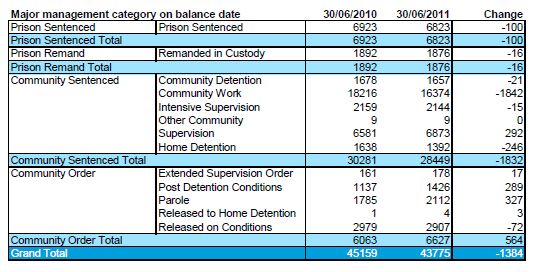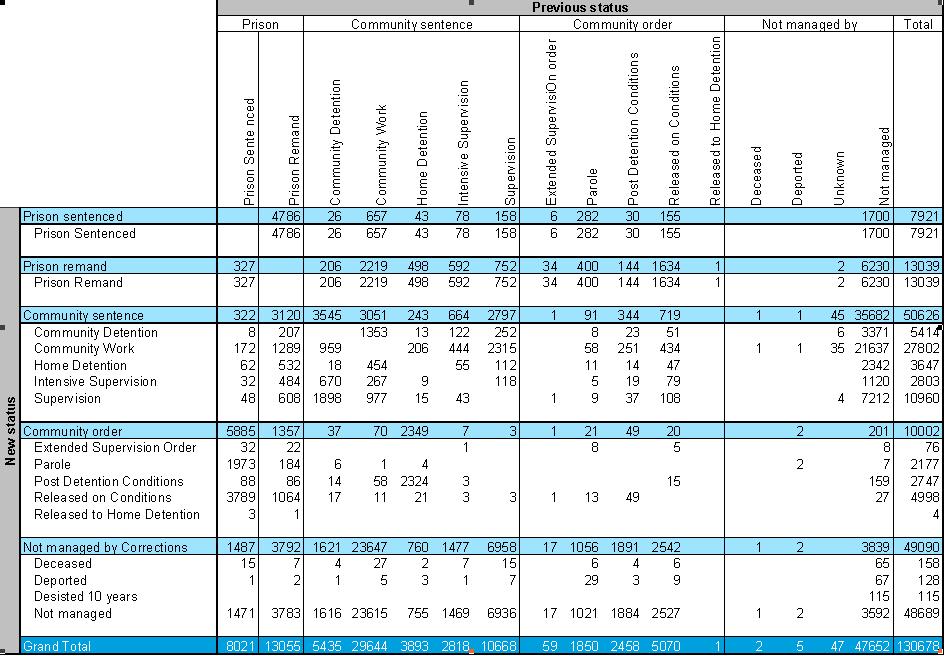10 Offender inventory
10.1 Overview
This section provides the offender inventory analysis for the 2010/2011 financial year in the form of an overall balance sheet and summary of inflow and outflow transitions.
To enable this form of analysis, each offender’s history has been simplified to a single timeline comprising his/her major management periods experienced, with enforcement of a one-day/one-status approach. So that analysis of transitions from one status to another can be usefully made, offenders subject to overlapping or concurrent forms of management are counted only once on any given date.
As a consequence, an individual offender described as transitioning from Remand status to Community Work status could result from:
- a remand prisoner being sentenced to start a new period of community work
- an offender on community work being remanded in custody, and then reverting to the original community work sentence.
The reason for the transition is not part of this report. The offender inventory, and consequently the whole Offender Volumes Report, describes episodes of management rather than sentences.
Note that this implies that the numbers in the current report may differ from those reported elsewhere by the Department of Corrections.
Offender flows and balances in the various management pools are detailed, such that the opening balance, plus inflows less outflows, equals the closing balance. In keeping with this inventory approach, offenders’ status at year’s commencement is carried forward from the previous year.
The number of transitions from one management group to another group gives an indication of the amount of work relating to the annual throughput. The different amounts of work associated with different forms of transition (for example, a new reception into prison versus a transition from remand status to sentenced status) and knowing the volumes associated with the different transitions is useful management information.
10.2 2011 Restatement of historic balances
The build of the Offender Volumes Report data set will periodically be revised as historical data issues are identified and corrected.
This occurred in the 2011 restatement (relative to the 2007 and 2009 versions) of all offender histories, as the methodology for constructing offender timelines has changed. The impact of this has been relatively minor, with the balances at any given snapshot date in the 2007 and 2009 reports being slightly different from the current report. It is expected that future reports will move to an accrual process, with only the occasional need to restate history if research demonstrates that the historical data can be substantially improved.
10.3 Balance sheet

Individuals are only counted once. Where individuals could be categorised with more than one status they are grouped by their highest status in the above list. Status is based on records of directives and not manual muster records. In a small number of cases the data contains known errors. However, all individuals are included for completeness.
10.4 All major management transitions between categories of management
Transitions may be due to individuals having new directives and orders or reverting to a lower management status at termination or expiry of the previous status. In a small number of cases the data contains known errors. However all transitions are included for completeness.
Reading across the page gives the number of individuals transitioning to the status listed on the left hand side, with the columns indicating the status that individuals have come from. For example the Prison Remand row shows 13039 episodes of remand were started and the Prison Remand column shows 13055 episodes of remand were completed for a net decrease of 16
remand prisoners overall.


